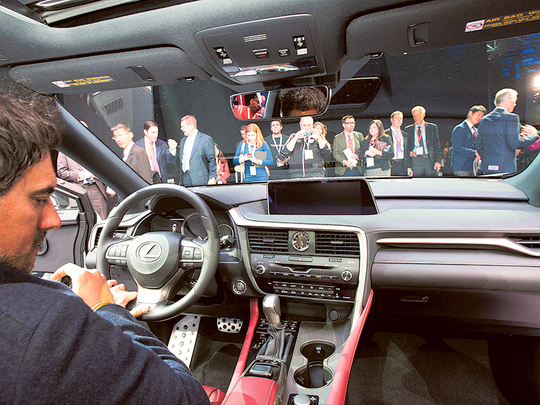
San Francisco: The Visa executive slips into the front seat of a new BMW, wakes up the tablet computer in the dashboard, and orders pizza. A few taps later and his lunch will be ready in 10 minutes at a nearby Pizza Hut. No need to pay at the restaurant — the car’s computer already did that for him.
Smartphones and, soon, Apple Watches can already function as quasi-wallets, able to store credit and debit card details that can be used to pay for goods in stores. The car is the next frontier, according to technology and payment executives.
“One car executive called me and said, ‘We really want to make the car your wallet’,” says Doug Brown, head of mobile for FIS, a maker of banking and payments software.
Thanks in part to the launch of Apple’s mobile payment app Apple Pay, retailers and shoppers are increasingly using mobile payments, industry members say. That is leading to greater interest from merchants and tech companies in developing new ways to buy goods, including car dashboard apps.
The revolution in mobile payments happens to coincide with a race by car and tech giants to make cars smarter. Consumers increasingly want their cars to have the same sophisticated technology, such as maps and music apps, as their smartphones.
Most new cars have minicomputers embedded in dashboards that can run apps or link up with smartphones to let drivers control their phones through the car’s touchscreen. Apple and Google have both released software for cars in the past two years, while manufacturers from Detroit to Tokyo are developing in-house connected car systems.
“This is where you start to get the pieces coming together,” says Ramon Martin, Visa’s global head of merchant solutions. “New commerce opportunities exist.”
The Pizza Hut and Visa app, demonstrated at a recent industry conference in San Francisco, will soon roll out for beta testing in northern California. Ford last year launched a similar partnership with pizza chain Domino’s, which lets drivers order pizza using a voice-activated app in their car.
“It makes you like Ford cars and Lincoln cars better because you’re not fumbling with your phone,” says Doug VanDagens, Ford’s director of connected services.
A variety of other uses for in-car payments are in development, including a system that integrates in-app payments with location sensors to let drivers pay for petrol through a car app.
But not everyone is sold on the idea that consumers want in-car payments.
Kebbie Sebastian, managing director of Penser Consulting, a payments consulting firm, says smartphones are ubiquitous and already carry most of the apps that the auto and payments industries are looking to integrate into dashboards.
“Paying from a car dashboard might be innovative but it isn’t any more convenient than paying from a smartphone,” says Mr Sebastian.
Mr VanDagens says companies like Ford are trying to make it more convenient by building car-specific app interfaces that are easy to operate while driving, such as voice-controlled apps or apps with simplified menus.
If they can get drivers using dashboard apps, they can remove the distraction of using a smartphone while driving. eCommerce apps, for example, are hugely popular, but any in-car commerce app will “absolutely not,” he says, include features related to flash sales or time-sensitive online auctions.
Those, Ford has decided, are too distracting. Carmakers hunt for share of the mobile wallet market
The Visa executive slips into the front seat of a new BMW, wakes up the tablet computer in the dashboard, and orders pizza. A few taps later and his lunch will be ready in 10 minutes at a nearby Pizza Hut. No need to pay at the restaurant — the car’s computer already did that for him.
Smartphones and, soon, Apple Watches can already function as quasi-wallets, able to store credit and debit card details that can be used to pay for goods in stores. The car is the next frontier, according to technology and payment executives.
“One car executive called me and said, ‘We really want to make the car your wallet’,” says Doug Brown, head of mobile for FIS, a maker of banking and payments software.
Thanks in part to the launch of Apple’s mobile payment app Apple Pay, retailers and shoppers are increasingly using mobile payments, industry members say. That is leading to greater interest from merchants and tech companies in developing new ways to buy goods, including car dashboard apps.
The revolution in mobile payments happens to coincide with a race by car and tech giants to make cars smarter. Consumers increasingly want their cars to have the same sophisticated technology, such as maps and music apps, as their smartphones.
Most new cars have minicomputers embedded in dashboards that can run apps or link up with smartphones to let drivers control their phones through the car’s touchscreen. Apple and Google have both released software for cars in the past two years, while manufacturers from Detroit to Tokyo are developing in-house connected car systems.
“This is where you start to get the pieces coming together,” says Ramon Martin, Visa’s global head of merchant solutions. “New commerce opportunities exist.”
The Pizza Hut and Visa app, demonstrated at a recent industry conference in San Francisco, will soon roll out for beta testing in northern California. Ford last year launched a similar partnership with pizza chain Domino’s, which lets drivers order pizza using a voice-activated app in their car.
“It makes you like Ford cars and Lincoln cars better because you’re not fumbling with your phone,” says Doug VanDagens, Ford’s director of connected services.
A variety of other uses for in-car payments are in development, including a system that integrates in-app payments with location sensors to let drivers pay for petrol through a car app.
But not everyone is sold on the idea that consumers want in-car payments.
Kebbie Sebastian, managing director of Penser Consulting, a payments consulting firm, says smartphones are ubiquitous and already carry most of the apps that the auto and payments industries are looking to integrate into dashboards.
“Paying from a car dashboard might be innovative but it isn’t any more convenient than paying from a smartphone,” says Mr Sebastian.
Mr VanDagens says companies like Ford are trying to make it more convenient by building car-specific app interfaces that are easy to operate while driving, such as voice-controlled apps or apps with simplified menus.
If they can get drivers using dashboard apps, they can remove the distraction of using a smartphone while driving. eCommerce apps, for example, are hugely popular, but any in-car commerce app will “absolutely not,” he says, include features related to flash sales or time-sensitive online auctions.
Those, Ford has decided, are too distracting.
— Financial Times











